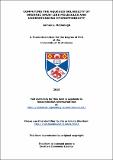Files in this item
Computing the aqueous solubility of organic drug-like molecules and understanding hydrophobicity
Item metadata
| dc.contributor.advisor | Mitchell, John B. O. | |
| dc.contributor.advisor | van Mourik, Tanja | |
| dc.contributor.author | McDonagh, James L. | |
| dc.coverage.spatial | xviii, 254 | en_US |
| dc.date.accessioned | 2015-04-22T14:26:18Z | |
| dc.date.available | 2015-04-22T14:26:18Z | |
| dc.date.issued | 2015-06-24 | |
| dc.identifier | uk.bl.ethos.644843 | |
| dc.identifier.uri | https://hdl.handle.net/10023/6534 | |
| dc.description.abstract | This thesis covers a range of methodologies to provide an account of the current (2010-2014) state of the art and to develop new methods for solubility prediction. We focus on predictions of intrinsic aqueous solubility, as this is a measure commonly used in many important industries including the pharmaceutical and agrochemical industries. These industries require fast and accurate methods, two objectives which are rarely complementary. We apply machine learning in chapters 4 and 5 suggesting methodologies to meet these objectives. In chapter 4 we look to combine machine learning, cheminformatics and chemical theory. Whilst in chapter 5 we look to predict related properties to solubility and apply them to a previously derived empirical equation. We also look at ab initio (from first principles) methods of solubility prediction. This is shown in chapter 3. In this chapter we present a proof of concept work that shows intrinsic aqueous solubility predictions, of sufficient accuracy to be used in industry, are now possible from theoretical chemistry using a small but diverse dataset. Chapter 6 provides a summary of our most recent research. We have begun to investigate predictions of sublimation thermodynamics. We apply quantum chemical, lattice minimisation and machine learning techniques in this chapter. In summary, this body of work concludes that currently, QSPR/QSAR methods remain the current state of the art for solubility prediction, although it is becoming possible for purely theoretical methods to achieve useful predictions of solubility. Theoretical chemistry can offer little useful additional input to informatics models for solubility predictions. However, theoretical chemistry will be crucial for enriching our understanding of the solvation process, and can have a beneficial impact when applied to informatics predictions of properties related to solubility. | en_US |
| dc.language.iso | en | en_US |
| dc.publisher | University of St Andrews | |
| dc.relation | Palmer D.S., McDonagh J.L., Mitchell J. B. O., van Mourik T, Fedorov MV. First-principles calculation of the intrinsic aqueous solubility of crystalline druglike molecules. Journal of Chemical Theory and Computation. 2012;8(9):3322-37. | en_US |
| dc.relation | McDonagh J.L., Nath N., De Ferrari L, Van Mourik T, Mitchell J.B. O. Uniting Cheminformatics and Chemical Theory To Predict the Intrinsic Aqueous Solubility of Crystalline Druglike Molecules. Journal of chemical information and modeling. 2014;54(3):844-56. | en_US |
| dc.relation | Skyner R, McDonagh J. L., Groom C. R., van Mourik T, Mitchell J. B. O. A Review of Methods for the Calculation of Solution Free Energies and the Modelling of Systems in Solution. Physical Chemistry Chemical Physics. 2015. | en_US |
| dc.rights | Creative Commons Attribution-NonCommercial-NoDerivatives 4.0 International | |
| dc.rights.uri | http://creativecommons.org/licenses/by-nc-nd/4.0/ | |
| dc.subject | Solubility | en_US |
| dc.subject | Drug-like | en_US |
| dc.subject | Computational chemistry | en_US |
| dc.subject | Solubility prediction | en_US |
| dc.subject | Hydrophobicity | en_US |
| dc.subject | Sublimation | en_US |
| dc.subject | Melting point | en_US |
| dc.subject | Crystal structure | en_US |
| dc.subject | Chemistry | en_US |
| dc.subject | Intrinsic solubility | en_US |
| dc.subject.lcc | QD543.M37 | |
| dc.subject.lcsh | Solubility | en_US |
| dc.subject.lcsh | Sublimation (Chemistry) | en_US |
| dc.subject.lcsh | Melting points | en_US |
| dc.title | Computing the aqueous solubility of organic drug-like molecules and understanding hydrophobicity | en_US |
| dc.type | Thesis | en_US |
| dc.contributor.sponsor | Scottish Universities Life Sciences Alliance (SULSA) | en_US |
| dc.type.qualificationlevel | Doctoral | en_US |
| dc.type.qualificationname | PhD Doctor of Philosophy | en_US |
| dc.publisher.institution | The University of St Andrews | en_US |
This item appears in the following Collection(s)
Except where otherwise noted within the work, this item's licence for re-use is described as Creative Commons Attribution-NonCommercial-NoDerivatives 4.0 International
Items in the St Andrews Research Repository are protected by copyright, with all rights reserved, unless otherwise indicated.


